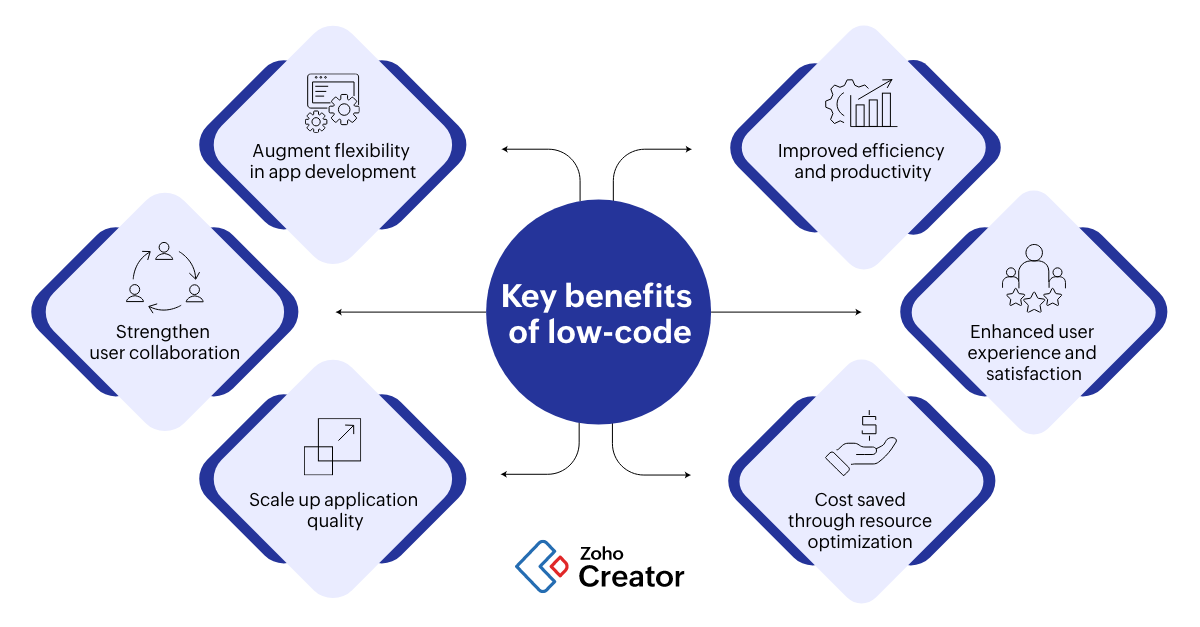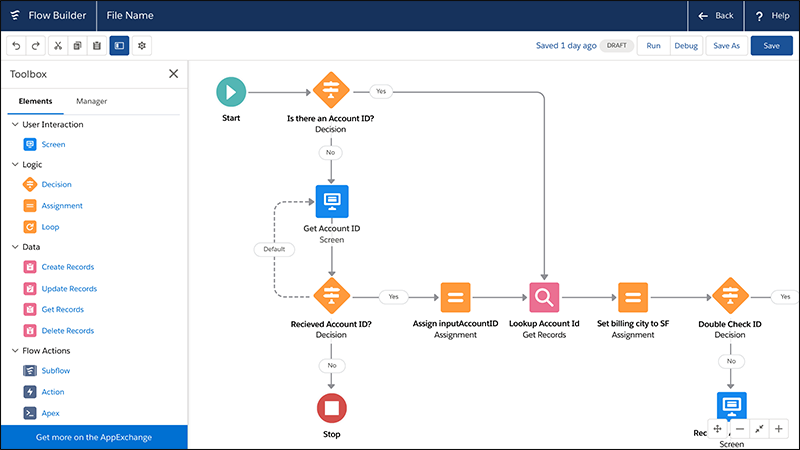Good Ideas On Deciding On Legacy application modernization with Low-code
Good Ideas On Deciding On Legacy application modernization with Low-code
Blog Article
Benefits Of Low-Code Development For Non-Developers With Regard To Accessibility
The following main factors make low-code development available to non-developers.
Drag-and-Drop Builders: Low-code platforms have drag-and-drop interfaces which allow non-developers to design applications without needing to write code. This makes it simpler for people who don't have technical background to participate in the process of development.
WYSIWYG: WYSIWYG editors are "What you See is What you Get" editors that permit users to create workflows and interfaces in a similar manner as the final product. This makes it simpler to understand and use.
Simplified Workflow and Logic Design
Visual Workflow modeling: Users design business processes and application logic using visual flowcharts. These models are more intuitive to work with than traditional codes.
Low-code platforms usually come with pre-built logic elements (e.g. condition statements, loops), which reduce the need for complicated coding.
Reusable Components and Templates
Library of Pre-built Templates: A lot of low-code platforms provide templates for common applications that allow non-programmers to begin from a solid base and alter as required.
Reusable Modules and Widgets: Utilizing modular and widgets that can be reused, users can speed up the creation process, while also reducing the requirement for technical knowledge.
Tutorials for Guided Development and Guided Development
Step-by-Step Guides: Platforms often offer guided development paths or online tutorials screen-based instructions that can assist those who are not developers in developing applications.
Interactive Tutorials - Interactive tutorials that let you engage with the platform can help you learn and gain confidence.
Integration with existing tools
Seamless Integration - Low-code platforms can be easily integrated with existing systems and business tools (e.g. ERP CRM, ERP), allowing even non-developers the ability to develop apps that work into their workflows.
APIs connectors and APIs: These devices make integration easier by allowing non-developers (or even users) to link their applications with external services.
Collaboration Features:
Team Collaboration: Features such as real-time collaboration and shared workspaces enable non-developers to collaborate with professionals, business analysts, and other stakeholders effectively.
Access control based on role: Role levels are able to be set for those who are not developers to ensure they can still contribute to the development process, but without compromising the security.
Automated Testing and Debugging
Low-code platform often comes with integrated testing and debugging tools which automates this process. Non-developers can now easily ensure their application works correctly.
Platform identifies errors as they occur and offers fixes. This helps non-developers with troubleshooting.
The main benefit of developing applications using low-code for accessibility to non-developers is in its ability to make the development process more accessible. With its intuitive, visually-guided tools and experiences, low-code platforms let business owners actively participate and maintain applications. Read the top rated Low-code Platform for application development for more info including push notifications android, rad development, azure sql, cloud software applications, build a docker container, develop mobile application, low code development platforms, cross platform app development, cross platform app development, application modernization software and more.
Benefits Of Low Code Application Development For Governance And Security
Low-code development offers many benefits in terms of security and governance. These are crucial for ensuring applications are secure, compliant and properly managed throughout their lifecycle. Here are the key benefits: Centralized Governance
Unified management console: Low code platforms usually provide a central administration console from which administrators can manage all applications and ensure consistent governance within the company.
Role-Based Access Control RBAC (RBAC). These platforms often have robust access control that is that is based on roles, giving administrators the ability to define and implement their own access policies. Only authorized users are permitted to modify and access certain areas of the application.
Compliance and Regulatory Applicability:
Many low-code platforms come with built-in compliance features. These are designed to ensure that apps comply with industry standard (e.g. GDPR, HIPAA). They offer frameworks and instruments that ensure applications meet the specifications.
Audit Trails: Many organizations integrate comprehensive logging and audit trail systems, which enable the organization to monitor changes as well as track access, and ensure that they are in compliance with internal as well as external rules and regulations.
Improved Security Measures
Data Encryption : Low-code platforms often offer built-in data encryption in transit and at rest. This guarantees that sensitive data is protected.
Security Certificates: Many low-code companies have a security certificate (e.g. ISO 27001 and SOC 2) which demonstrate their adherence to strict security standards. They provide an additional security level to their customers.
Automated Security Updates
Regular Updates and Patches Low code platforms typically are equipped to handle patches and security updates regularly. This ensures that applications are protected against the most recent security threats, and without developers having to manually handle.
Security Monitoring: Continuous monitoring of security tools are typically used, which provide real-time alerts as well as insights into security risks that might be present.
Data Governance
Data Access Policies These systems permit organisations to create data access rules and enforce them, ensuring data is available only to users who are authorized. They also make sure that the data is being used in a safe manner.
Data Masking and Anonymization: Tools built in for data masking & anonymization ensure the security of sensitive information, especially in testing environments and development environments.
Consistent Lifecycle Management of Applications
Development and Deployment pipelines: Lowcode platforms typically provide integrated pipelines for development and deployment that include security tests. They ensure protection throughout the lifecycle of the application.
Version Control: Integrated version control allows for the management of changes. It also ensures that all modifications to the software can be recorded, and if required, reversed. This ensures the integrity of the software.
Authorization and User Authentication:
Single Sign On (SSO) Single sign-on as well as other advanced authentication techniques simplify management of users while increasing security.
Multi-Factor Authentication (MFA): Many platforms provide built-in support to multi-factor authentication, adding an extra layer of security to access applications.
Policy Enforcement and Compliance:
Low-code platforms are usually designed with policies that are pre-defined to assist companies in implementing governance and security policies quickly.
Compliance Monitoring Tools: These provide continuous monitoring and report on compliance status. This helps to identify potential issues and address them proactively.
Integration with Existing Security Infrastructure
Integration seamless: Low-code platforms can be easily integrated with the existing security tools and devices like firewalls, SIEM solutions (Security Information and Event Management), and identity management systems.
API Security: API security features built-in ensure integrations with external systems, protecting the integrity of data as well as ensuring the integrity of the applications.
Training and best Practices
Guided Best Practices: A number of platforms offer guidelines and best methods for secure application development, helping non-developers adhere to security standards.
Security Training: A few low-code vendors offer security training and resources to educate users on how to design and build secure applications.
Overall the security and governance advantages of developing applications using low-code make sure that applications are created and managed in a secure, compliant, and controlled manner. These platforms offer the tools and frameworks needed to secure sensitive data, enforce policies, and maintain regulatory compliance, all while facilitating the administration and supervision of the process of developing applications. Check out the best Legacy application modernization with Low-code tips for website recommendations including no code platforms, build a docker container, paas service, build with docker, driver jdbc, app development platform, build a docker container, driver jdbc, build with docker, low code platforms and more.
The Benefits Of Developing Applications Using Low-Code In Workflow And Collaboration
Low-code development has many advantages in collaboration and workflow. This makes it an ideal option for companies looking to boost productivity and simplify the development process. Here are a few of the benefits that are most notable: Improved cross-functional collaboration:
Unified Development Environment. Low-code platforms enable all team members to work in a single and integrated environment. This includes business analysts, developers, designers, and stakeholder. This helps eliminate silos and encourages greater communication.
Visual Development Visual Development: The low-code platform's visually drag-and-drop features make it easy for nontechnical team participants to contribute in the process of design. It also makes sure that business needs are properly documented and implemented.
Communication Enhanced
Real-time collaboration: A lot of low code platforms provide real-time communication features like simultaneous editing and commenting. Instant feedback is also available. This reduces the amount of time required for back and forth discussion.
Workspaces shared by teams. Teams can collaborate on shared workspaces. In this workspace, they can see, edit, and discuss various project components.
Streamlined Workflow:
Built-in Project Management Tools: Low-code platforms typically have integrated project management software that aids teams plan, track, control, and coordinate their development projects. This includes the management of tasks, tracking progress and deadline management.
Workflow Automation: The automated execution of routine tasks, workflows, as well as other processes reduces the amount of manual work required and also eliminates errors. This lets teams concentrate on tasks that are more profitable and improves efficiency.
More Rapid Iteration:
Rapid Prototyping: Low-code platforms allow rapid prototyping. They also allow iterative and rapid development. This allows teams to develop apps, test them and refine them within shorter time frames. This ensures that feedback can be quickly integrated and improvements implemented quickly.
Agile Development Support: Support for agile methodologies allows team members to work on sprints. They can continuously deliver small improvements in functionality and more easily adapt to the changing needs.
Accessibility for non-developers:
Citizen Development: Low-code platforms allow business users (citizen developers) to create and modify applications with no coding expertise. This reduces the burden on IT and development departments and helps them react quicker to the needs of business.
Training and Onboarding - Simple interfaces, comprehensive training resources and intuitive interfaces make it easy for new team members to get up to speed and improve the overall team's cooperation.
Centralized documentation knowledge sharing, dissemination and documentation:
Documentation is integrated into low code platforms are often equipped with the tools needed to create and manage documentation on the platform, making it simple for all project information to be centralized.
Knowledge Repositories. Teams are able to build and manage knowledge repositories, which include best practices templates and reusable component, facilitating sharing of knowledge and decreasing the amount of duplicate work.
Consistency in Standardization
Standardized Components : The use pre-built, standardized components provides consistency between the different applications. This makes it simpler for team members to grasp the different components of a given project and to work on these components.
Governance and Compliance - The built-in governance frames ensure that the development of every application adheres to organizational standards as well as the regulatory requirements. This reduces non-compliance risk and assures that the application is compliant with the highest quality standards.
Feedback Loops and Improvement Loops
Integrated Feedback: Low-code platforms provide users with feedback mechanisms integrated into them which allow them to give users with feedback quickly on their applications. This feedback can be later integrated into the application development process.
Continuous Improvement: The capability to rapidly iterate, deploy and change applications based on feedback from users helps them align to the company's goals and users' needs.
Visualization and Reporting
Real-Time Analytics: Built-in analytics and reporting tools offer real-time information on the performance of your project, its progress, and user interactions, enabling data-driven decision-making.
Visual Workflow Analysis Visual tools are used to visualize workflows and processes. These tools assist teams determine and improve their workflows.
Low-code application development can be a very effective tool to collaborate and streamline workflow. It brings together different teams, simplifies communication and automates processes. This creates a more flexible, efficient and collaborative environment for development. This ultimately results in better-quality applications and better alignment of business objectives.